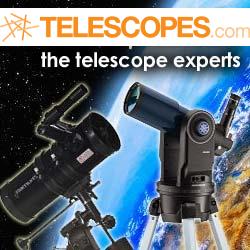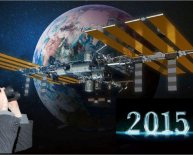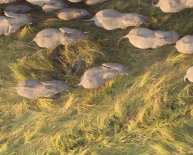
Astronomical bodies list
 Within the Solar System:
Within the Solar System:
outside the Solar System:
What's up in the sky this month: courtesy of
Of course the Sun is within the Solar System and is a star, however as we are talking primarily about night sky observing I have not included it. It will be discussed in the section on stars, plus the Sun should never be directly looked at ever and especially with a telescope or binoculars without special made solar filters.
If you have ever looked at the night sky you have seen stars, planets, and the Moon. You quite possibly have even seen a galaxy and a nebula or two without realizing it.
Many celestial objects on the list are visible to the naked eye although not in any detail. To us here on Earth they all look like points of light.
Grab a pair of binoculars and space becomes a viewing treat.
Orion Binoculars - a perfect fit for everyone!With a telescope and good viewing conditions, a treasure of sights await.
Admittedly there are no details to be observed except on the Moon of course, but seeing the moons of Jupiter or the rings of Saturn is quite enjoyable.
Orion's Best Beginner Telescopes!Celestial Bodies Within The Solar System
All the other planets are visible to the naked eye except Neptune. Uranus is tough to see but at times is naked-eye visible but I suggest binoculars at the very least to hunt for it.
You need help to see the moons or natural satellites of other planets. The four large moons of Jupiter and Titan of Saturn are possible for the newbie to find.
How about the dwarf planets? Remember our friend Pluto? Formerly a planet but now the first of the Plutoids. These are very hard to spot but with some patience and good dark skies they can be found telescopically.
There are even visible asteroids out there for the backyard stargazer. Vesta though is the only one visible to the naked eye if you know where to look and have dark skies.
What about comets? Giant ice balls whizzing through the solar system on their long orbit around the sun and out beyond Neptune.
At some point you may have caught a chance “falling or shooting star “. This is a meteor streaking through the atmosphere. Or maybe you ventured out to see the latest meteor shower.
Celestial Bodies Outside The Solar System
Outside the solar system is of course the many stars we see every night. There are different types of stars and we'll talk about some of them in the star section of the site.
There are different galaxies floating around out there waiting for you to view them. The Andromeda galaxy is the farthest object visible from earth to the naked eye. With binoculars or telescopes many more come to light.
Various nebulae are also waiting to be seen. In the Orion constellation the Orion Nebula is naked-eye visible and the Crab Nebula in the Taurus constellation is visible in binoculars. Although it will not look like it does in this picture. In the nebula section I’ll tell you about some of the different types of nebulae and where they can be observed.
Ready for some deep sky observing? Click on a link above to learn about that topic and some celestial objects to view in that category.
› Celestial Bodies














